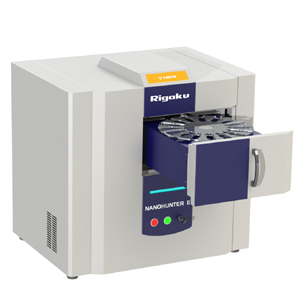Rigaku Announces the NANOHUNTER II Benchtop Total Reflection X-Ray Fluorescence (TXRF) Spectrometer
X-ray scientific, analytical and industrial instrumentation manufacturer Rigaku Corporation, has announced the next generation Rigaku NANOHUNTER II benchtop total reflectance X-ray fluorescence (TXRF) spectrometer that enables high-sensitivity ultra-trace elemental analysis, in liquids or on solid surfaces, to the parts-per-billion (ppb) level. Total reflection X-ray fluorescence spectroscopy is a method by which an incident beam of X-rays just grazes the sample, delivering low-background noise, high-sensitivity measurement of ultra-trace elements.
Due to increasingly stringent environmental regulations, there is rising demand for a simpler method of conducting analyses down to the ppb level with regard to, for example, arsenic (As), selenium (Se) and cadmium (Cd) contained in factory waste liquids and effluent streams. Using the NANOHUNTER II spectrometer, analysis down to the ppb level becomes possible, even with a very small sample size, merely by adding a drop of liquid to the sample carrier, drying it, and then performing the measurement. Quantitative analyses using internal standard substances can also be easily performed.
The NANOHUNTER II TXRF analyzer combines a fully automatic optical axis adjustment system that provides stable high-sensitivity analysis in an easily handled benchtop form factor that allows quick and trouble-free operation. With a high-power 600 W X-ray source, a newly developed mirror (optic) and a large-area silicon drift detector (SDD), the NANOHUNTER II spectrometer enables high-intensity, high-sensitivity measurements. The lower limit of Cd detection is 2 ppb. For As and Se in a liquid, a detection lower limit of 0.8 ppb or less has been achieved.
One important advantage is the high efficiency with which K? lines can be excited. Until now, exciting K? lines in atomic no. 48 Cd has been very challenging, so practitioners relied on analysis using L-lines, which are difficult to measure. The newly developed optic employed in this device can be used with a high-power excitation source of about 30 keV, which makes it possible to measure K? lines with high signal-to-noise ratios and clearly defined peaks (when measuring Cd). Wide adoption of this capability is expected in fields such as the screening and analysis of factory waste liquids and the analysis of beverages, as such as wine.
In the area of analysis of solid surfaces, there is demand (primarily in the fields of thin films and thick films) for analyses that penetrate slightly deeper than the surface. For this kinds of analyses, a methodology called grazing incidence X-ray fluorescence (GI-XRF) is employed whereby the elements beneath the surface are excited by varying the incident angle of the X-ray source. Because the NANOHUNTER II spectrometer has the necessary functionality to vary the angle of incidence, it is possible to perform depth profile surface analyses. The GI-XRF technique is applicable to nanoscale research.
Between September 2 and September 4, the NANOHUNTER II spectrometer will be exhibited at JASIS (previously known as JAIMA EXPO/SIS) at the Makuhari Messe.
Unique Capabilities
- Detection of a wide range of elements –
Can detect elements from Al (aluminum, atomic no. 13) to U (uranium, atomic no. 92). - Measures extremely small samples –
With liquid samples, 10 ?L 50 ?L is an adequate quantity, one to two orders of magnitude less than the amount required for common chemical analysis methods. This can easily meet the requirements for forensic investigation, where it is desirable that non-destructive methods be used to analyze trace amounts of evidence. - Automatic measurement –
By using a 16-sample changer mechanism, automatic operation (for example, overnight operation) becomes possible. - No special requirements for device installation – Runs regular AC power and does not require gas for analysis.
Main points of improvements compared to previous NANOHUNTER instrument
- New high-power X-ray source
Incorporates a 600 W X-ray source. Achieves a dramatic increase in power compared to the previous 50 W source. - Molybdenum (Mo) excitation results in 100x improvement in sensitivity
With Copper (Cu) excitation (8 keV) sensitivity is improved 10x and with Mo excitation (18 keV) sensitivity is improved 100x. Elements with atomic numbers 3041 between Cu and Mo can be excited with high efficiency and due to the newly developed multilayer mirror optic, K? lines can now be excited for atomic numbers 4449. - Competitive pricing
Various technological innovations have been adopted to achieve lower prices, such as the use of Mo tubes to measure light elements, which means that the unit need be equipped with only one X-ray tube.
Posted September 1, 2015


